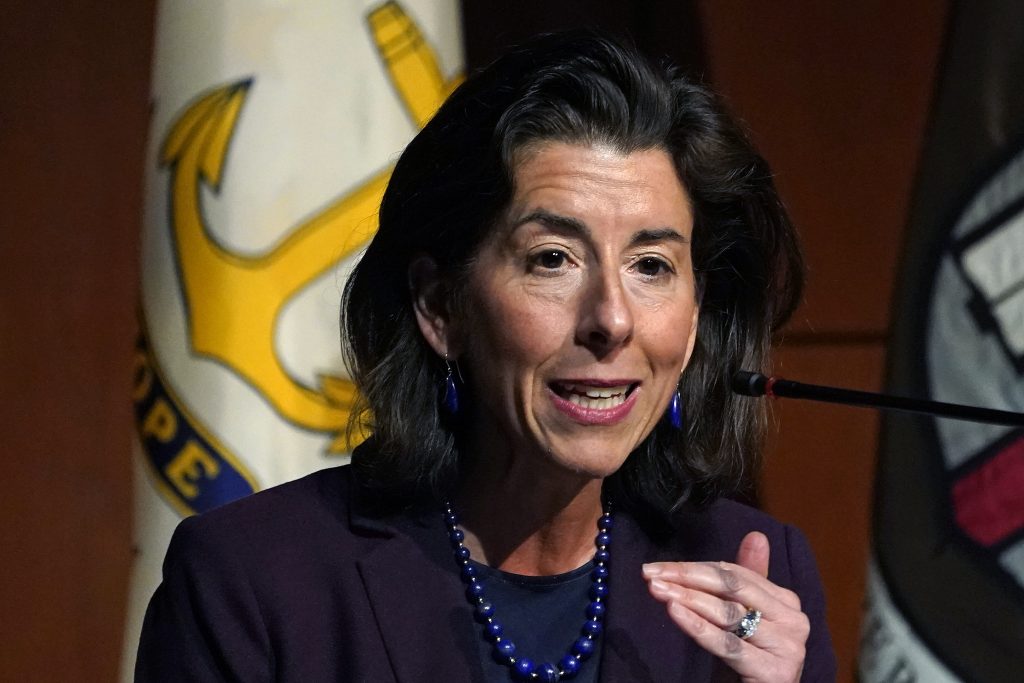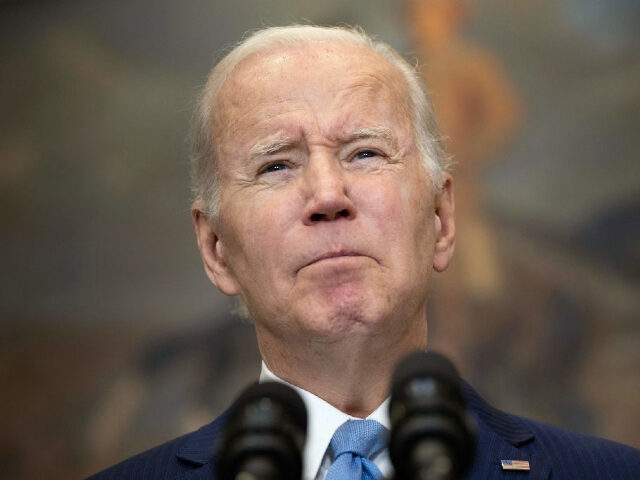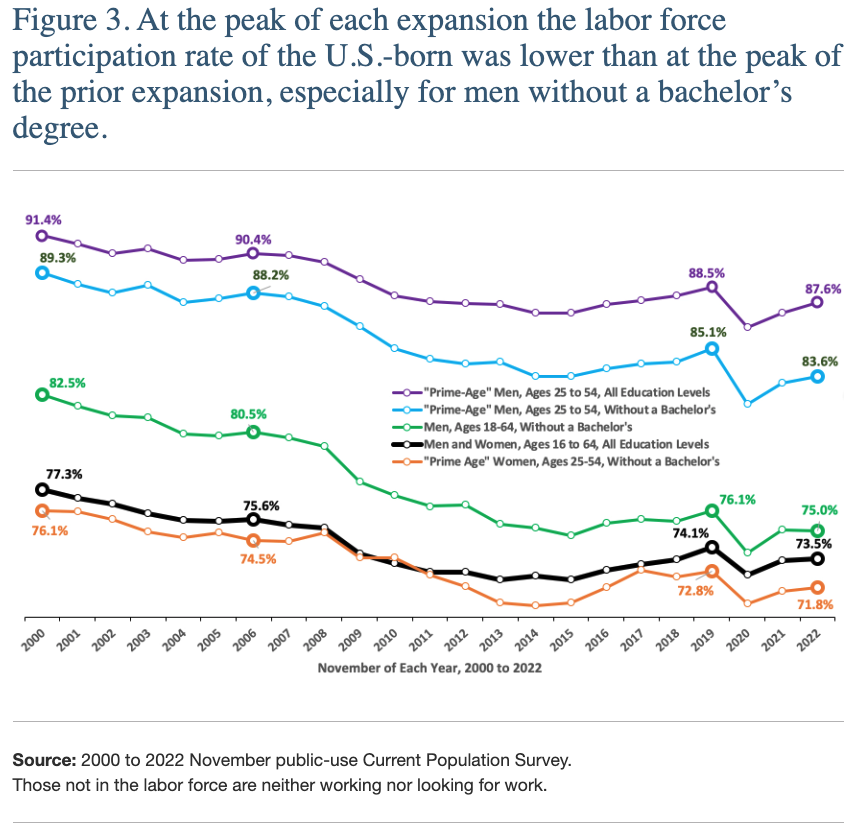President Joe Biden has pulled at least 1.9 million additional wage-cutting workers from poor countries, more than reversing the temporary gain under President Donald Trump, according to government data reported by the Center for Immigration Studies.
Biden’s high-migration policies have also contributed to the loss of 2.1 million working Americans who have quit the workforce amid disease, inflation, low wages, bad working conditions, and government disregard, according to the December 21 report by CIS research director Steven Camarota.
The report noted:
In November 2022, there were 29.6 million immigrants (legal and illegal together) working in the United States — 1.9 million more than in November 2019, before the pandemic.
The 29.6 million immigrant workers in November of this year was one million above the long-term trend in the pre-Covid growth rate of immigrant workers — [so] immigrant workers are not “missing”.
In contrast to immigrants, there were 2.1 million fewer U.S.-born Americans working in November 2022 than in November 2019, before the pandemic.
…
In November of this year, there were 44.9 million working-age [emphasis added] U.S.-born Americans not in the labor force — nearly 10 million more than in 2000.
The U.S.-born working-age population has increased in size since 2000, but if their labor force participation rate was what it was in 2000, there would be 6.5 million more Americans in the labor force.
“The availability of immigrant labor allows us as a society to ignore the plight of all those [Americans] on the economic sidelines,” Camarota told Breitbart News:
There are all kinds of Americans who were working just until two years ago, that are sitting on the sidelines now. … Some of them are young, and they’ve just been out for a little bit. Some have been out for a long time and will never get back. For men, we’re not likely to get back to the labor-force participation rate of the 1960s or even the 1980s. But if it returned to what it was in in the 2000s, that would be six million more workers.
The flood of immigrant labor minimizes the economic pressure on government and business to get American men and women back to work, he added:
It seems extremely unlikely that we will undertake the difficult task of reforming the welfare and disability systems, of trying to retrain people, trying to re-instill the value of work, of trying to help people get off drugs and alcohol … as long as businesses are successful in bringing in foreign workers and foreign countries [such as Cuba and Venezuela] are so successful in … using immigration as a [political] safety valve.
It would be a problem [getting sidelined Americans back to work] because it involves everything from opioid addiction and obesity to people with criminal records, to people who are dependent on welfare and disability and so forth. Trying to reform all that is a Herculean task. It’s just easier to bring in foreign workers
“The left wing has made the word ‘replacement’ a bad word, he said. “All these people that are calling for more immigration are saying, in effect, ‘Look, we need to replace these American workers who are not in the labor force.'”
The “hire migrants” message is being pushed by Biden’s deputies, including labor secretary Marty Walsh and commerce secretary Gina Raimondo.
“The thing that’s underpinning inflation still — that’s driving inflation still — is this tight labor market” that allows Americans to bargain for higher wages, Raimondo told Axios.com on December 20. “Immigration is a [policy] lever … We’re down a million immigrants a year — that’s a workforce that we need.”

Secretary of Commerce Gina Raimondo speaks during an address at Brown University, March 15, 2022, in Providence, Rhode Island (AP Photo/Charles Krupa)
The message is also being pushed by influential elites. Camarota pointed to a December 19 article in the establishment outlet Foreign Affairs, where two activist professors at Harvard University and Dartmouth College called for more use of immigrants because they can help cut inflation by working for lower wages:
There is something else that U.S. policymakers could do to battle inflation, however. They could expand immigration for both skilled and less skilled workers to boost the supply capacity of the U.S. economy. More immigration would help meet today’s excess demand for labor, which over time would limit wage and price growth.
…
In addition to offsetting the long-term decline of U.S. birthrates, foreign-born workers have the virtue of being much more mobile than native-born workers. When job growth picks up in one region or drops off in another, workers born abroad are the first to respond, helping reduce regional misallocations in the U.S. labor supply.
Read @gordon_h_hanson and Matthew J. Slaughter on the rapid decline in immigration to the United States—and how this trend has made it harder for U.S. labor markets to function properly. https://t.co/VTggH3dXdr
— Foreign Affairs (@ForeignAffairs) December 21, 2022
The two Harvard and Dartmouth authors lament the Trump-era decline of the illegal population — and the resulting wage increases and improved workplace conditions for Americans. They argued:
By the end of 2021, the share of entertainment, accommodation, and food service workers who were foreign born had slipped to 18.4 percent — a drop of more than 3.5 percentage points. Meanwhile, the job vacancy rate in the hospitality industry has increased markedly; in October 2022, 9.2 percent of jobs in accommodation and food services were vacant, well above the economy-wide rate of 6.3 percent.
The authors uncritically accept business claims that they have “an astonishing 10.3 million job openings.” They called for an enormous increase in the supply of temporary foreign blue-collar labor and of indentured white-collar workers:
A much higher cap [for H-2B laborers], as much as ten times the current one, should be authorized for 2023 … Last academic year, there were 914,095 such international students in the United States. This coming spring, why not congratulate every one of these foreign-born students who graduates with the gift of a new H-1B visa?
The article downplays the inflow of roughly 1.5 million work-ready people through the southern border in 2022.
The professor’s article exemplifies the elites’ ruthless post-2016 divorce from ordinary Americans. The authors even reject the hope of moving Americans back into the labor force, saying in their subheadline, “Only Foreign Workers Can Alleviate U.S. Labor Shortages.”
“Expanding immigration could also be a political winner,” the two authors gushed, despite much contradictory evidence that politicians understand.
They even lament the gains for U.S. workers for Trump and complained his politics led to “an increasingly native [non-immigrant] workforce.”
The two wealthy authors also ignored the potential for automation, or trade with low-wage countries, and the many downsides of betting on indentured foreign workers for national security and economic growth.
Aided by the government’s migration programs, many U.S. sectors prefer to use cheap and disposable migrant workers instead of hiring well-paid Americans to operate labor-saving machines:
Amadeo sent us this video where he and his co-workers were harvesting strawberries despite freezing rain and cold temps. He says on days like this, it's very slippery because of the mud and we have to be careful not to slip and fall. But this job supports my family. #WeFeedYou pic.twitter.com/DhlObk6eFj
— United Farm Workers (@UFWupdates) December 15, 2022
Foreign companies, however, are developing the productivity-boosting technology that U.S. investors ignore:
“Compared with their 1980–1982 level, non-college men’s relative earnings have followed a consistent downward trend over the last 40 years, despite periodic real earnings gains,” said a 2022 study by Pinghui Wu at the Federal Reserve Bank of Boston:
For many workers, a job not only offers financial security, it also affirms their status, which is tied to their position relative to their age peers and many social outcomes … the results indicate that changes in relative earnings account for 44 percent of the total growth in labor force exit among non-college men during the 1980–2019 period. This finding suggests that deteriorating social status is a plausible key factor driving prime-age men’s declining labor force participation.
Immigration “decouples [a nation’s economic] capital from its own country, from its own people,” Camarota noted, adding that the rush of new migrants is also imposing extra burdens on Americans’ schools, communities, and social services:
Those calling for more immigration to fill jobs must at least acknowledge that the number of legal and illegal immigrants is already at a record 48.4 million. One-in-seven U..S residents is now an immigrant, and that’s just slightly below the record set in 1890, 122 years ago. Those numbers have profound implications for the nation’s schools and healthcare and physical infrastructure, to say nothing of whether we can actually assimilate all of them.
“If you’re just thinking about immigration as an economic issue, you miss what’s happening in schools and across the host of social issues,: he added.
Read @gordon_h_hanson and Matthew J. Slaughter on the rapid decline in immigration to the United States—and how this trend has made it harder for U.S. labor markets to function properly. https://t.co/VTggH3dXdr
— Foreign Affairs (@ForeignAffairs) December 21, 2022
Extraction Migration
Government officials try to grow the economy by raising exports, productivity, and the birth rate. But officials want rapid results, so they also try to expand the economy by extracting millions of migrants from poor countries to serve as extra workers, consumers, and renters.
This policy floods the labor market and so it shifts vast wealth from ordinary people to older investors, coastal billionaires, and Wall Street. It makes it difficult for Americans to advance in their careers, get married, raise families, buy homes, or gain wealth.
Extraction Migration slows innovation and shrinks Americans’ productivity. This happens because migration allows employers to boost stock prices by using stoop labor and disposable workers instead of the skilled American professionals and productivity-boosting technology that earlier allowed Americans and their communities to earn more money.
This migration policy also reduces exports because it minimizes shareholder pressure on C-suite executives to take a career risk by trying to grow exports to poor countries.
Outside government, migration also undermines employees’ workplace rights, and it widens the regional economic gaps between the Democrats’ cheap-labor coastal states and the Republicans’ heartland and southern states.
An economy fueled by Extraction Migration also drains Americans’ political clout over elites and it alienates young people. It radicalizes Americans’ democratic civic culture because it gives a moral excuse for wealthy elites and progressives to ignore despairing Americans at the bottom of society, such as drug addicts.
This diversify-and-rule investor strategy is enthusiastically pushed by progressives. They wish to transform the U.S. from a society governed by European-origin civic culture into an economic empire of jealous identity groups overseen by progressive hall monitors. “We’re trying to become the first multiracial, multi-ethnic superpower in the world,” Silicon Valley Rep. Rohit Khanna (D-CA) told the New York Times in March 2022. “It will be an extraordinary achievement … We will ultimately triumph,” he boasted.
But the progressive-backed, colonialism-like migration policy kills many migrants. It exploits the poverty of migrants and splits foreign families as it extracts human resources from poor home countries to serve wealthy U.S. investors.
Progressives hide this Extraction Migration economic policy behind a wide variety of noble-sounding explanations and theatrical border security programs. Progressives claim the U.S. is a “Nation of Immigrants,” that economic migrants are political victims, that migration helps migrants more than Americans, and that the state must renew itself by replacing populations.
Similarly, establishment Republicans, businesses, and GOP donors hide the pocketbook impact. They prefer to divert voters’ attention toward border chaos, welfare spending, terror-linked migrants, migrant crime, and drug smuggling.
Many polls show the public wants to welcome some immigration. But the polls also show deep and broad public opposition to labor migration and to the inflow of temporary contract workers into the jobs needed by the families of blue-collar and white-collar Americans.
This “Third Rail” opposition is growing, anti-establishment, multiracial, cross-sex, non-racist, class-based, bipartisan, rational, persistent, and recognizes the solidarity that American citizens owe to one another.


COMMENTS
Please let us know if you're having issues with commenting.